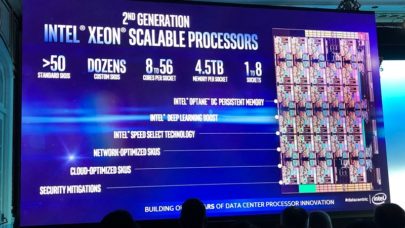
Intel Gold U-Series SKUs Reveal Single Socket Intentions
April 18, 2019
Intel plans to jump into the single socket market with a portion of its just announced Cascade Lake microprocessor line according to one media report. This isn� Read more…

AMD’s EPYC Road to Redemption in Six Slides
June 21, 2018
A year ago AMD returned to the server market with its EPYC processor line. The earth didn’t tremble but folks took notice. People remember the Opteron fondly Read more…

New Photoresist Could Add Years to Moore’s Law
July 17, 2014
Over the last five decades, microprocessors have gotten cheaper and more powerful as predicted by Gordon Moore's famous observation, which states that the numbe Read more…

Graphene Faces Real-World Limitations
May 5, 2014
Graphene is a one-atom-thick layer of carbon that has been hailed as a potential silicon replacement capable of extending the exponential computing advances tha Read more…

New Research Advances Heterogenous 3D Chip Design
February 6, 2014
As transistors approach the limits of miniaturization, the rapid pace of progress in the microprocessor industry is destined to start declining unless researche Read more…

Russia Sets Its Sights on Exascale
March 27, 2012
While much attention has focused on China's rising supercomputing prospects lately, a number of other countries, including Russia, are also quickly muscling up their HPC resources. With their eyes set on exascale, Russia is planning to invest over a billion dollars this decade to field at least one such system by 2020. Read more…

Designer of Microprocessor-Memory Chip Aims to Topple Memory and Power Walls
January 17, 2012
Whether you're talking about high performance computers, enterprise servers, or mobile devices, the two biggest impediments to application performance in computing today are the memory wall and the power wall. Venray Technology is aiming to knock down those walls with a unique approach that puts CPU cores and DRAM on the same die. The company has been in semi-stealth mode since it inception seven years ago, but is now trying to get the word out about its technology as it searches for a commercial buyer. Read more…

The Expanding Floating-Point Performance Gap Between FPGAs and Microprocessors
November 22, 2010
For the past several years, Field Programmable Gate Arrays (FPGAs) have been getting large enough to compete with microprocessors in floating-point performance. Using the theoretical peak performance numbers, the FPGA's floating-point performance is growing faster than microprocessors. This article calculates the peak performance for several FPGA devices from Xilinx and compares them to a reference microprocessor for equivalent time periods and shows that this gap in performance is growing. Read more…

- Click Here for More Headlines

Whitepaper
Transforming Industrial and Automotive Manufacturing
In this era, expansion in digital infrastructure capacity is inevitable. Parallel to this, climate change consciousness is also rising, making sustainability a mandatory part of the organization’s functioning. As computing workloads such as AI and HPC continue to surge, so does the energy consumption, posing environmental woes. IT departments within organizations have a crucial role in combating this challenge. They can significantly drive sustainable practices by influencing newer technologies and process adoption that aid in mitigating the effects of climate change.
While buying more sustainable IT solutions is an option, partnering with IT solutions providers, such and Lenovo and Intel, who are committed to sustainability and aiding customers in executing sustainability strategies is likely to be more impactful.
Learn how Lenovo and Intel, through their partnership, are strongly positioned to address this need with their innovations driving energy efficiency and environmental stewardship.
Download Now
Sponsored by Lenovo
Whitepaper
How Direct Liquid Cooling Improves Data Center Energy Efficiency
Data centers are experiencing increasing power consumption, space constraints and cooling demands due to the unprecedented computing power required by today’s chips and servers. HVAC cooling systems consume approximately 40% of a data center’s electricity. These systems traditionally use air conditioning, air handling and fans to cool the data center facility and IT equipment, ultimately resulting in high energy consumption and high carbon emissions. Data centers are moving to direct liquid cooled (DLC) systems to improve cooling efficiency thus lowering their PUE, operating expenses (OPEX) and carbon footprint.
This paper describes how CoolIT Systems (CoolIT) meets the need for improved energy efficiency in data centers and includes case studies that show how CoolIT’s DLC solutions improve energy efficiency, increase rack density, lower OPEX, and enable sustainability programs. CoolIT is the global market and innovation leader in scalable DLC solutions for the world’s most demanding computing environments. CoolIT’s end-to-end solutions meet the rising demand in cooling and the rising demand for energy efficiency.
Download Now
Sponsored by CoolIT
Advanced Scale Career Development & Workforce Enhancement Center
Featured Advanced Scale Jobs:
HPCwire Resource Library
HPCwire Product Showcase
© 2024 HPCwire. All Rights Reserved. A Tabor Communications Publication
HPCwire is a registered trademark of Tabor Communications, Inc. Use of this site is governed by our Terms of Use and Privacy Policy.
Reproduction in whole or in part in any form or medium without express written permission of Tabor Communications, Inc. is prohibited.
























